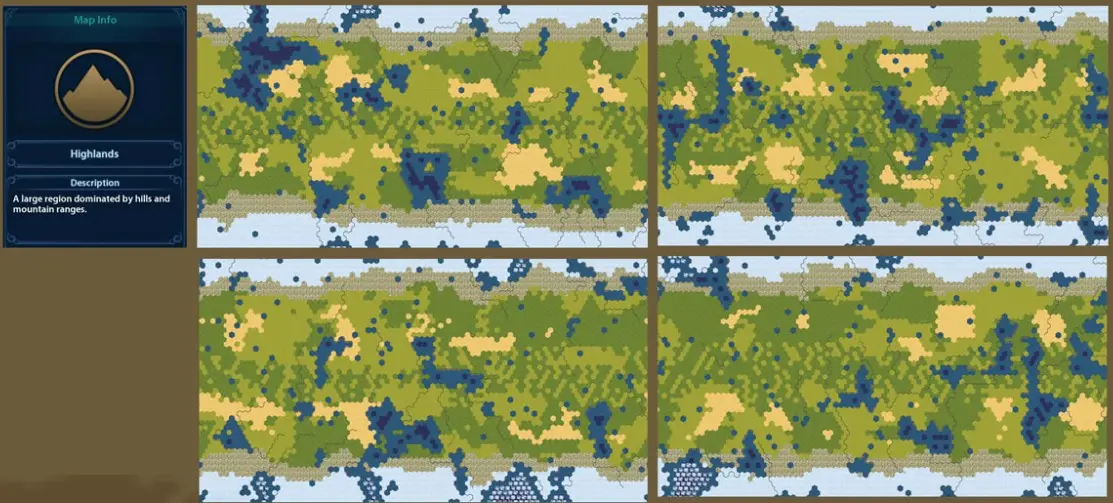I’m diving into the world of Civilization 6 Gathering Storm maps to give you a visual feast. I’ve played multiple rounds and handpicked examples of each map type that stood out to me. My focus is on cylindrical maps – those that wrap around east to west. I’m setting aside non-wrapping maps and Earth-related maps, as they’re pretty self-explanatory.
Unique Maps: Clover and Snowflake
Starting with the peculiar ones – the Six-Arm Snowflake and the Four-Leaf Clover. These maps are perfect for team play or duels, featuring balanced regions aimed at pushing players towards a central showdown. Each arm or “leaf” is identical, hosting a mix of terrains from forests to plains, and occasionally tundra towards the center. They stand out for their symmetry and strategic possibilities.

Land-Rich Maps: Lakes and Highlands
Transitioning to maps with abundant land, the Lakes map emerges as a land dominator. Despite its name, lakes are minimal, creating vast expanses of land ripe for civilization. Interestingly, one example diverged, presenting ocean-like lakes, offering a unique gameplay experience.
Highlands follow suit, dominated by hills and mountains, resembling the Lakes map but with an elevated ruggedness. It’s akin to a landlocked paradise for those favoring terrestrial dominance.


A Sea of Land: Seven Seas
The Seven Seas map, despite its nautical name, is surprisingly land-rich. It presents a Pangaea sliced by bodies of water, creating canals and interconnected seas. This map favors strategic canal construction and poses a unique challenge for naval-focused civilizations.

The Unpredictable: Primordial
Primordial maps take you back to the earth’s tumultuous youth, featuring unpredictable continents, islands, and an abundance of volcanic activity. Its layout varies wildly, from fragmented landmasses to near-Pangaea formations, ensuring no two games are alike.

A Favorite: Continents and Islands
Continents and Islands strike a balance between land and sea, making it one of my preferred maps. It typically features two to three main continents peppered with islands, offering diverse gameplay. Whether it’s two large landmasses or multiple smaller ones, this map encourages exploration and naval prowess. The main point to note that 90% of the time there is a shallow water passage, explorable before Cartography tech.

The Wild Card: Splintered Fractal
Splintered Fractal lives up to its name with a highly random layout, often resulting in thin, snaking continents and islands. Its unpredictable nature makes it perfect for players seeking a unique challenge, with maps ranging from interconnected land bridges to expansive peninsulas.

The Classics: Continents, Terra, and Fractal
Continents and Terra offer familiar gameplay with a few twists. Continents usually feature two main landmasses, while Terra has all major civilizations starting on one large continent, leaving the other ripe for exploration. Fractal, meanwhile, surprises with its unpredictable formations, from snaky landmasses to large Pangaea-like continents.

Navigating the Waters: Small Continents and Island Plates
As we venture into more water-centric maps, Small Continents and Island Plates depict a world dominated by vast oceans. These maps favor naval civilizations, offering numerous opportunities for island settlements and maritime dominance.


Island Galore: Archipelago
Archipelago promises a world of many small islands but often includes several large landmasses as well. It’s a paradise for civilizations like Indonesia, capable of thriving in a maritime world yet offers enough variety to keep all players on their toes.

Lush Lands: Wetlands
Lastly, the Wetlands map, with its rivers and marshes, provides a fertile ground for civilizations like Khmer or Vietnam. It combines continents connected by shallow waters, allowing for early exploration and strategic settlements.

I hope this visual guide sparks new strategies and excites you for your next Civilization 6 adventure.


